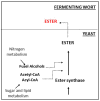Beer Molecules and Its Sensory and Biological Properties: A Review
- PMID: 31009997
- PMCID: PMC6515478
- DOI: 10.3390/molecules24081568
Beer Molecules and Its Sensory and Biological Properties: A Review
Abstract
The production and consumption of beer plays a significant role in the social, political, and economic activities of many societies. During brewing fermentation step, many volatile and phenolic compounds are produced. They bring several organoleptic characteristics to beer and also provide an identity for regional producers. In this review, the beer compounds synthesis, and their role in the chemical and sensory properties of craft beers, and potential health benefits are described. This review also describes the importance of fermentation for the brewing process, since alcohol and many volatile esters are produced and metabolized in this step, thus requiring strict control. Phenolic compounds are also present in beer and are important for human health since it was proved that many of them have antitumor and antioxidant activities, which provides valuable data for moderate dietary beer inclusion studies.
Keywords: alcoholic fermentation; beer; beer adjunct; phenolic compounds; volatile esters.
Conflict of interest statement
The authors declare no conflict of interest. The funders had no role in the design of the study; in the collection, analyses, or interpretation of data; in the writing of the manuscript, or in the decision to publish the results.
Figures



Similar articles
-
Beer volatile fingerprinting at different brewing steps.Food Chem. 2020 Oct 1;326:126856. doi: 10.1016/j.foodchem.2020.126856. Epub 2020 Apr 25. Food Chem. 2020. PMID: 32450481
-
Novel microencapsulated yeast for the primary fermentation of green beer: kinetic behavior, volatiles and sensory profile.Food Chem. 2021 Mar 15;340:127900. doi: 10.1016/j.foodchem.2020.127900. Epub 2020 Aug 26. Food Chem. 2021. PMID: 32871359
-
Characterization of the volatile profiles of beer using headspace solid-phase microextraction and gas chromatography-mass spectrometry.J Sci Food Agric. 2014 Mar 30;94(5):919-28. doi: 10.1002/jsfa.6336. Epub 2013 Sep 4. J Sci Food Agric. 2014. PMID: 23929274
-
Low-alcohol Beers: Flavor Compounds, Defects, and Improvement Strategies.Crit Rev Food Sci Nutr. 2016 Jun 10;56(8):1379-88. doi: 10.1080/10408398.2012.733979. Crit Rev Food Sci Nutr. 2016. PMID: 25118090 Review.
-
An Overview of Bioactive Phenolic Molecules and Antioxidant Properties of Beer: Emerging Trends.Molecules. 2023 Apr 4;28(7):3221. doi: 10.3390/molecules28073221. Molecules. 2023. PMID: 37049984 Free PMC article. Review.
Cited by
-
Influence of malt composition on the quality of a top fermented beer.J Food Sci Technol. 2021 Jun;58(6):2295-2303. doi: 10.1007/s13197-020-04740-8. Epub 2020 Aug 25. J Food Sci Technol. 2021. PMID: 33967326 Free PMC article.
-
Physiological Mechanisms by Which the Functional Ingredients in Beer Impact Human Health.Molecules. 2024 Jun 29;29(13):3110. doi: 10.3390/molecules29133110. Molecules. 2024. PMID: 38999065 Free PMC article. Review.
-
From Conventional to Craft Beer: Perception, Source, and Production of Beer Color-A Systematic Review and Bibliometric Analysis.Foods. 2024 Sep 18;13(18):2956. doi: 10.3390/foods13182956. Foods. 2024. PMID: 39335885 Free PMC article. Review.
-
On sample preparation methods for fermented beverage VOCs profiling by GCxGC-TOFMS.Metabolomics. 2020 Sep 19;16(10):102. doi: 10.1007/s11306-020-01718-7. Metabolomics. 2020. PMID: 32949264 Free PMC article.
-
A Review on the Obtaining of Functional Beers by Addition of Non-Cereal Adjuncts Rich in Antioxidant Compounds.Antioxidants (Basel). 2021 Aug 24;10(9):1332. doi: 10.3390/antiox10091332. Antioxidants (Basel). 2021. PMID: 34572969 Free PMC article. Review.
References
-
- Defernez M., Foxall R.J., O’Malley C.J., Montague G., Ring S.M., Kemsley E.K. Modelling beer fermentation variability. J. Food Eng. 2007;83:167–172. doi: 10.1016/j.jfoodeng.2007.02.033. - DOI
-
- Hager A.S., Taylor J.P., Waters D.M., Arendt E.K. Gluten free beer—A review. Trends Food Sci. Technol. 2014;36:44–54. doi: 10.1016/j.tifs.2014.01.001. - DOI
-
- Grassi S., Amigo J.M., Lyndgaard C.B., Foschino R., Casiraghi E. Assessment of the sugars and ethanol development in beer fermentation with FT-IR and multivariate curve resolution models. Food Res. Int. 2014;62:602–608. doi: 10.1016/j.foodres.2014.03.058. - DOI
Publication types
MeSH terms
Substances
Grants and funding
LinkOut - more resources
Full Text Sources

